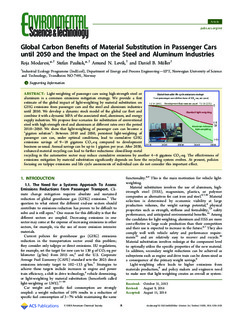| dc.contributor.author | Modaresi, Roja | |
| dc.contributor.author | Pauliuk, Stefan | |
| dc.contributor.author | Løvik, Amund Nordli | |
| dc.contributor.author | Müller, Daniel Beat | |
| dc.date.accessioned | 2014-11-03T22:51:13Z | |
| dc.date.accessioned | 2015-09-07T09:29:27Z | |
| dc.date.available | 2014-11-03T22:51:13Z | |
| dc.date.available | 2015-09-07T09:29:27Z | |
| dc.date.issued | 2014 | |
| dc.identifier.citation | Environmental Science and Technology 2014, 48:10776-10784 | nb_NO |
| dc.identifier.issn | 0013-936X | |
| dc.identifier.uri | http://hdl.handle.net/11250/298886 | |
| dc.description.abstract | Light-weighting of passenger cars using high-strength steel or
aluminum is a common emissions mitigation strategy. We provide a first
estimate of the global impact of light-weighting by material substitution on
GHG emissions from passenger cars and the steel and aluminum industries
until 2050. We develop a dynamic stock model of the global car fleet and
combine it with a dynamic MFA of the associated steel, aluminum, and energy
supply industries. We propose four scenarios for substitution of conventional
steel with high-strength steel and aluminum at different rates over the period
2010−2050. We show that light-weighting of passenger cars can become a
“gigaton solution”: Between 2010 and 2050, persistent light-weighting of
passenger cars can, under optimal conditions, lead to cumulative GHG
emissions savings of 9−18 gigatons CO2-eq compared to development
business-as-usual. Annual savings can be up to 1 gigaton per year. After 2030,
enhanced material recycling can lead to further reductions: closed-loop metal
recycling in the automotive sector may reduce cumulative emissions by another 4−6 gigatons CO2-eq. The effectiveness of
emissions mitigation by material substitution significantly depends on how the recycling system evolves. At present, policies
focusing on tailpipe emissions and life cycle assessments of individual cars do not consider this important effect. | nb_NO |
| dc.language.iso | eng | nb_NO |
| dc.publisher | Trans Tech Publications | nb_NO |
| dc.title | Global Carbon Benefits of Material Substitution in Passenger Cars until 2050 and the Impact on the Steel and Aluminum Industries | nb_NO |
| dc.type | Journal article | nb_NO |
| dc.type | Peer reviewed | en_GB |
| dc.date.updated | 2014-11-03T22:51:13Z | |
| dc.source.pagenumber | 10776-10784 | nb_NO |
| dc.source.volume | 48 | nb_NO |
| dc.source.journal | Materials Science Forum | nb_NO |
| dc.identifier.doi | 10.1021/es502930w | |
| dc.identifier.cristin | 1151921 | |
| dc.relation.project | Norges forskningsråd: 209697 | nb_NO |
| dc.description.localcode | Copyright © 2014 American Chemical Society. This is the authors' accepted and refereed manuscript to the article. | nb_NO |
